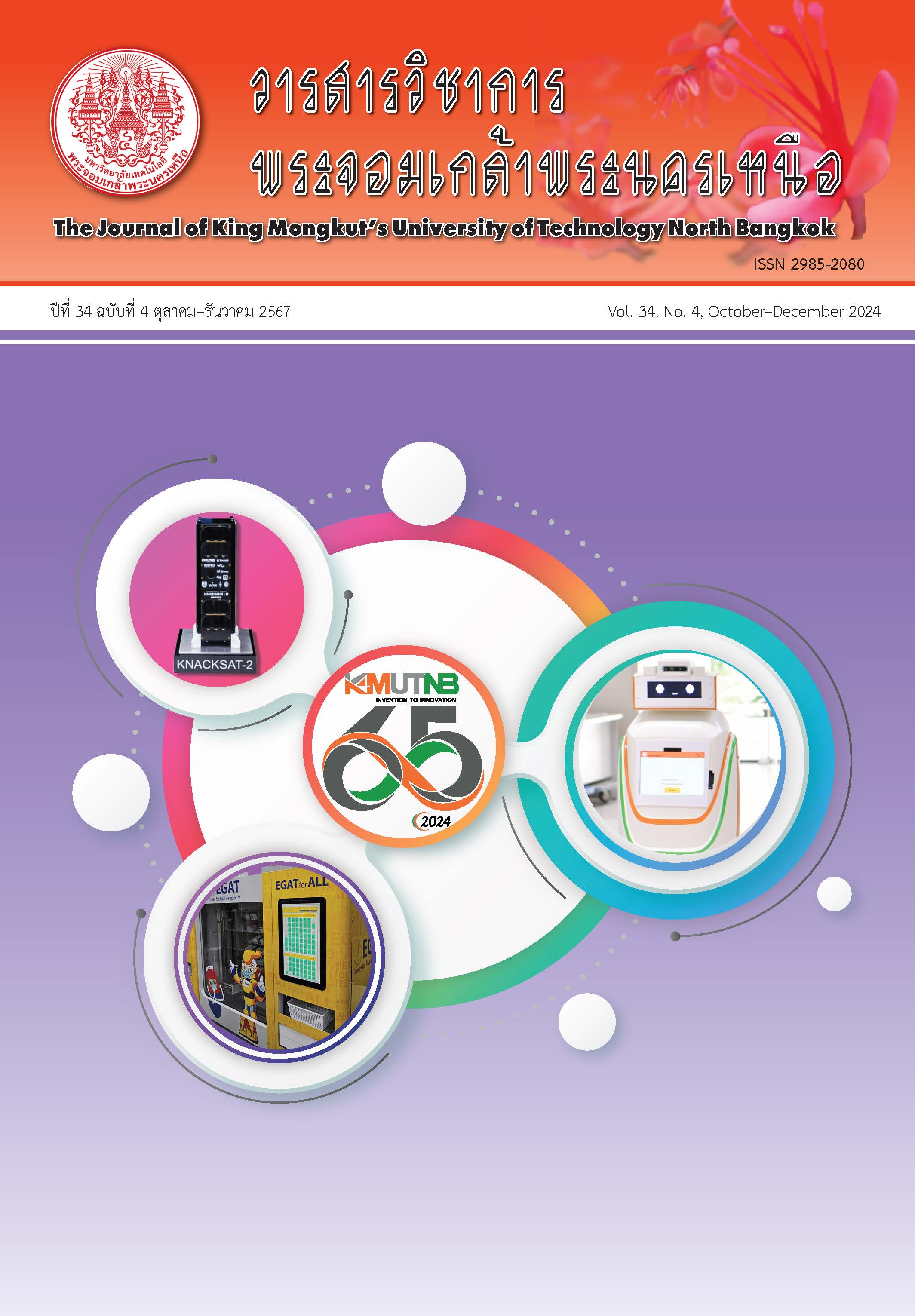การเปรียบเทียบประสิทธิภาพวิธีการคัดเลือกตัวแปรอิสระสำหรับตัวแบบการถดถอยไวบูลไม่ต่อเนื่อง
Main Article Content
บทคัดย่อ
งานวิจัยนี้มีวัตถุประสงค์เพื่อนำเสนอประสิทธิภาพการคัดเลือกตัวแปรอิสระของตัวแบบการถดถอยไวบูลไม่ต่อเนื่องทั้งหมด 4 วิธี ได้แก่ วิธีการถดถอยทีละขั้น วิธีบูตสแทร็ปทีละขั้น วิธีแบบเบส์ภายใต้การแจกแจงก่อนคือการแจกแจงปรกติ และวิธีแบบเบส์ภายใต้การแจกแจงก่อนคือการแจกแจงลาปลาซ โดยเปรียบเทียบประสิทธิภาพของวิธีการคัดเลือกตัวแปรด้วยอัตราความสำเร็จ รวมถึงได้ศึกษาประสิทธิภาพของการประมาณค่าพารามิเตอร์ด้วยค่าเฉลี่ยของค่าคลาดเคลื่อนกำลังสองเฉลี่ยจากการจำลองด้วยเทคนิคมอนติคาร์โลภายใต้สถานการณ์ที่ตัวแปรอิสระมีความสัมพันธ์เชิงเส้นพหุและไม่มีความสัมพันธ์เชิงเส้นพหุ ตัวแบบผ่านฟังก์ชันเชื่อมโยงแบบล็อก-ล็อกและลอจิต และลักษณะของข้อมูลตัวแปรตามมีการกระจายต่ำกว่าเกณฑ์และการกระจายเกินเกณฑ์ นอกจากนั้นผู้วิจัยยังนำทั้ง 4 วิธีมาประยุกต์ใช้กับข้อมูลจริง ผลจากการจำลองโดยสรุปพบว่าโดยส่วนใหญ่วิธีบูตสแทร็ปทีละขั้นให้ประสิทธิภาพดีที่สุด วิธีแบบเบส์จะมีประสิทธิภาพรองลงมาและให้ประสิทธิภาพดีที่สุดเมื่อขนาดตัวอย่างเท่ากับ 100 ส่วนวิธีการถดถอยทีละขั้นจะมีประสิทธิภาพน้อยที่สุดแต่จะมีประสิทธิภาพมากขึ้นเมื่อขนาดตัวอย่างมากขึ้น และผลจากการประยุกต์ใช้กับข้อมูลจริงพบว่าวิธีบูตสแทร็ปทีละขั้นให้ประสิทธิภาพดีที่สุด
Article Details

อนุญาตภายใต้เงื่อนไข Creative Commons Attribution-NonCommercial-NoDerivatives 4.0 International License.
บทความที่ลงตีพิมพ์เป็นข้อคิดเห็นของผู้เขียนเท่านั้น
ผู้เขียนจะต้องเป็นผู้รับผิดชอบต่อผลทางกฎหมายใดๆ ที่อาจเกิดขึ้นจากบทความนั้น
เอกสารอ้างอิง
A. C. Cameron and P. K. Trivedi, Regression Analysis of Count Data. Cambridge University Press, Cambridge: 2013.
K. F. Sellers and G. Shmueli, “A flexible regression model for count data,” The Annals of Applied Statistics, vol. 4, no. 2, pp. 943–961, 2010.
H. S. Klakattawi, “Discrete Weibull regression model for count data,” Ph.D dissertation, Department of Mathematics and Computing College of Engineering, Design and Physical Sciences, Brunel University, London, UK, 2017.
H. S. Klakattawi, V. Vinciotti, and K. Yu, “A simple and adaptive dispersion regression model for count data,” Entropy, vol. 20, no. 2, pp. 142, 2018.
H. Yoo, “Application of discrete Weibull regression model with multiple Imputation,” Communications for Statistical Applications and Methods, vol. 26, no. 3, pp. 325–336, 2019.
H. Haselimashhadi, V. Vinciotti, and K. Yu, “A novel Bayesian regression model for counts with an application to health data,” Journal of Applied Statistics, vol. 45, no. 6, pp. 1085–1105, 2018.
O. S. Adesina, A. S. Onanaye, and D. M. Okewole, “Bayesian Optimization for parameter of Discrete Weibull Regression,” Journal of Advances in Mathematics and Computer Science, vol. 34, no. 6, pp. 1–13, 2020.
D. M. Sakate, D. N. Kashid, and D. T. Shirhe, “Subset selection in poisson regression,” Journal of Statistical Theory and Practice, vol. 5, no. 2, pp. 207–219, 2011.
B. Efron, “Bootstrap methods: another look at the Jackknife,” The Annals of Statistics, vol. 7, no. 1, pp. 1–26, 1979.
N. Sudjai and M. Duangsaphon, “Liu-type logistic regression coefficient estimation with multicollinearity problem by using the bootstrapping method,” Science, Engineering and Health Studies, vol. 14, no. 3, pp. 203–214, 2020 (in Thai).
W. Saurerbrei and M. Schumacher, “A bootstrap resampling procedure for model building: Application to the cox regression model,” Statistics in Medicine, vol. 11, no. 16, pp. 2093–2109, 1992.
A. Ekman, “Variable Selection for the Cox proportional hazards model: A simulation study comparing the stepwise, lasso and bootstrap approach” M.S. thesis, Department of Mathematics and Mathematical Statistics, Umea University, 2011.
T. Nakagawa and S. Osaki, “The discrete Weibull distribution,” IEEE Transaction on Reliability, vol. 24, no. 5, pp. 300–301, 1975.
W. K. Hastings, “Monte Carlo sampling methods using markov chains and their applications,” Biometrika, vol. 57, no. 1, pp. 97–109, 1970.
H. Haario, E. Saksman, and J. Tamminen, “An adaptive Metropolis algorithm,” Bernoulli, vol. 7, no. 2, pp. 223–242, 2001.
G. K. Grunwald, S. L. Bruce, L. Jiang, M. Strand, and N. Rabinovitch, “A statistical model for underor overdispersed clustered and longitudinal count data,” Biometrical Journal, vol. 53, no. 4, pp. 578–594, 2011.
S. Gurmu, “Semiparametric estimation of hurdle regression models with an application to medicaid utilization,” Journal of Applied Econometrics, vol. 12, no, 3, pp. 225–242, 1997.

